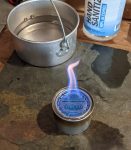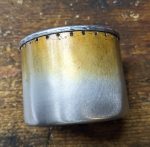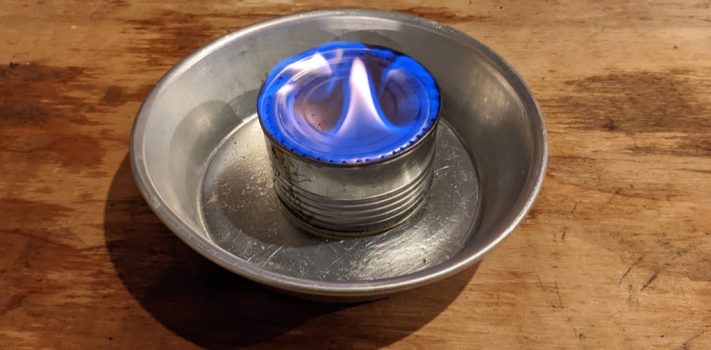My wife, “Kari” and I have some good friends with whom we have a Bible study each week. These friends, “Cool Hand Luke” and “Betsy Ross”, have become concerned about the direction our society is taking, and the potential disasters and disruptions that might result. They have begun stockpiling food and other supplies in order to help them better weather these potential disasters and disruptions.
During a recent Bible study, Betsy mentioned that although they had begun stockpiling food, they did not yet have a good way to cook that food in a grid-down situation. That comment served as a catalyst for a project that I had been contemplating about for quite some time.
I have previously written in SurvivalBlog about liquid hand sanitizer as a fuel for alcohol stoves. If it contains at least 80% ethanol, liquid hand sanitizer seems to burn just as well in alcohol stoves as the denatured alcohol marine stove fuel for which they are designed. The hand sanitizer can also be used for a host of other purposes such as disinfecting wounds, cleaning oral thermometers, treating athlete’s foot, thinning aftershave, and even sanitizing hands.
Since our local thrift stores have been selling donated liquid hand sanitizer for as little as 50 cents a gallon, that makes it a great value as an alternative fuel for alcohol stoves. I decided to see if I could make a homemade hand-sanitizer-fueled stove that would cook as well as common commercial models.
My inspiration was the penny stove described in The Official MacGyver Survival Manual. Directions for making a penny stove are widely available online at sites such as this one.
There were two reasons that I wanted to deviate from the common penny stove design. The first was that penny stoves are made from aluminum beverage cans, which would tend to be fragile. The second was that I don’t generally drink beverages from aluminum cans, so that I did not have any of that type of can available. With those limitations in mind, I decided to move my efforts in a different direction.
Prototype 1
 For my first attempt, I took two steel vegetable cans, one just slightly larger than the other. I made a line around each can about 1.75 inches from the bottom of the can, and then used an angle grinder to cut along each line.
For my first attempt, I took two steel vegetable cans, one just slightly larger than the other. I made a line around each can about 1.75 inches from the bottom of the can, and then used an angle grinder to cut along each line.
I then drilled a series of 1/16 inch holes around the perimeter of the bottom of the larger can, each hole about 1/4 inch from the next, giving me a total of 41 holes.
Next, I placed a slate tile on my work surface, placed the smaller can on the tile, and poured 80% ethanol liquid hand sanitizer into the can. I then placed the larger can upside down over the smaller can, poured about a tablespoon of hand sanitizer onto the bottom of the larger can, and lit the hand sanitizer with a permanent metal match. After the hand sanitizer on the larger can burned off, the fire went out. I tried a second time with the same results.
Next, I took the lid of Kari’s old Girl Scout mess kit, placed the prototype in the lid, poured some hand sanitizer into the lid, and lit it again. This resulted in some flame through the holes in the bottom of the larger can, but the results were rather feeble. I needed a tighter seal between the larger and smaller cans.
I blew out the flame, and attached a layer of Gorilla tape around the smaller can before once again covering it with the larger can. The seal was better, but still not sufficient to produce effective flames. I decided to try another tack.
Prototype 2
 I had a three-pack of 2 5/8 ounce Sterno cans that I had purchased at a thrift store for a couple of dollars. I took one of the Sterno cans, removed the label, and opened the lid. I boiled enough water to float the can, and then placed it into the hot water in an attempt to liquify the Sterno gel. The attempt was largely unsuccessful. Finally I took a knife and cut chunks of Sterno gel out of the can, and transferred the chunks into the two remaining cans. When most of the gel had been removed, I burned the last remnants of the gel out of the can.
I had a three-pack of 2 5/8 ounce Sterno cans that I had purchased at a thrift store for a couple of dollars. I took one of the Sterno cans, removed the label, and opened the lid. I boiled enough water to float the can, and then placed it into the hot water in an attempt to liquify the Sterno gel. The attempt was largely unsuccessful. Finally I took a knife and cut chunks of Sterno gel out of the can, and transferred the chunks into the two remaining cans. When most of the gel had been removed, I burned the last remnants of the gel out of the can.
Next, I drilled a series of 21 holes, each 1/16 inch in diameter, around the perimeter of the lid. Each hole was about 1/4 inch from the others.
I then filled the can with liquid hand sanitizer, put on the lid, filled the lid with hand sanitizer, and ignited the hand sanitizer in the lid. After the hand sanitizer in the lid was consumed, the alcohol vapor coming through the holes in the lid was sufficient to sustain a flame, but it was not very powerful. After burning for a half hour with no improvement, I extinguished the flame.
I concluded that the holes in the lid were directing the flames toward each other, where they were competing for oxygen. I decided that I needed a new design that directed the flames outward instead.
Prototype 3
 I drilled a series of 32 holes, each 1/16 inch in diameter, around the perimeter of the outside top of the Sterno can. I filled the can with liquid hand sanitizer, put a fresh lid on the can, and placed the can in the lid of Kari’s Girl Scout mess kit.
I drilled a series of 32 holes, each 1/16 inch in diameter, around the perimeter of the outside top of the Sterno can. I filled the can with liquid hand sanitizer, put a fresh lid on the can, and placed the can in the lid of Kari’s Girl Scout mess kit.
Next I poured a little extra hand sanitizer into the lid of the mess kit to help pre-heat the stove. I then lit the hand sanitizer in the mess kit.
The extra hand sanitizer in the mess kit lid was consumed within about a minute. By that time, the 32 holes of prototype 3 were putting out vigorous jets of flame. I allowed the stove to burn for about 15 minutes, and was very pleased with the quality of the flame.
Side by Side Test #1
For my next round of testing, I took the burner from a commercial Norwegian “Storm Kitchen” alcohol stove, prototype 3, and a regular can of Sterno, and placed them in the lids of three identical mess kits on a couple of slate tiles. I filled the commercially-made stove and prototype 3 with liquid hand sanitizer, and lit the two stoves and the regular Sterno can at the same time.
I put a grating over the three heat sources, put two cups of water each into three identical pots, and placed a pot over each heat source.
The water over prototype 3 boiled in just a few minutes, even before the commercially-made stove self-pressurized. I was surprised that the homemade unit boiled the water faster than the commercially-made unit.
After seven minutes, the commercially-made stove self-pressurized, and the water over it boiled seven minutes after that. The water over the regular can of Sterno steamed for a long time, but could never quite come to a boil. Finally, after a total of 30 minutes, I extinguished the can of Sterno.
Side by Side Test #2
 The next day I tested the commercially-made unit and prototype 3 side by side to boil three cups of water each. During this test, the commercially-made unit and the homemade unit each pressurized almost simultaneously after about five minutes. The water over the homemade unit boiled five minutes after that. The water over the commercially-made unit boiled after an additional five minutes still. Once again, the homemade unit had outperformed the commercially made unit.
The next day I tested the commercially-made unit and prototype 3 side by side to boil three cups of water each. During this test, the commercially-made unit and the homemade unit each pressurized almost simultaneously after about five minutes. The water over the homemade unit boiled five minutes after that. The water over the commercially-made unit boiled after an additional five minutes still. Once again, the homemade unit had outperformed the commercially made unit.
The Demonstration
 The next day, Luke and Betsy came over for our weekly Bible Study. After dinner, Bible study, and prayer, the four of us went out to the pole barn for a demonstration of the homemade stove. The demonstration consisted of another side-by side test of the commercial and homemade units. Once again, the homemade unit significantly outperformed the commercial unit, boiling three cups of water in about half the time.
The next day, Luke and Betsy came over for our weekly Bible Study. After dinner, Bible study, and prayer, the four of us went out to the pole barn for a demonstration of the homemade stove. The demonstration consisted of another side-by side test of the commercial and homemade units. Once again, the homemade unit significantly outperformed the commercial unit, boiling three cups of water in about half the time.
Luke and Betsy were happy with the performance of the homemade stove. I sent them home with the stove and a gallon of liquid hand sanitizer. They now have a way to cook in a short-term grid-down situation.
Conclusions
 Using an empty Sterno can, it is possible to construct a homemade alcohol stove that can use 80% ethanol liquid hand sanitizer as fuel. This homemade stove is capable of heating water faster than commercially-made stoves constructed according to the most commonly used design burning the same fuel as the homemade stove.
Using an empty Sterno can, it is possible to construct a homemade alcohol stove that can use 80% ethanol liquid hand sanitizer as fuel. This homemade stove is capable of heating water faster than commercially-made stoves constructed according to the most commonly used design burning the same fuel as the homemade stove.
During a short-term grid-down situation, a homemade stove using liquid hand sanitizer as fuel could provide a relatively clean and quiet cooking solution.
For longer-term grid-down situations, twig stoves that are fueled by an abundant, naturally renewable biomass may provide an ongoing cooking solution after manmade fuels become scarce.
Disclaimer
I did not receive any financial or other inducement to mention any vendor, product, or service in this article.










